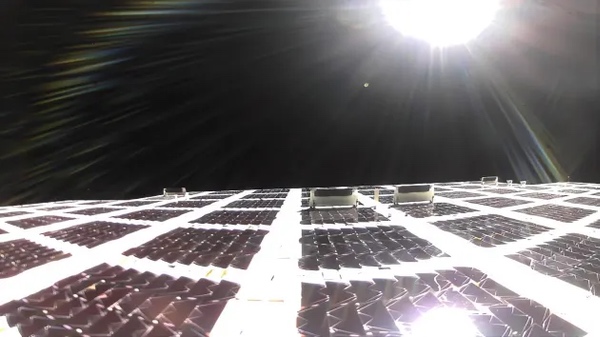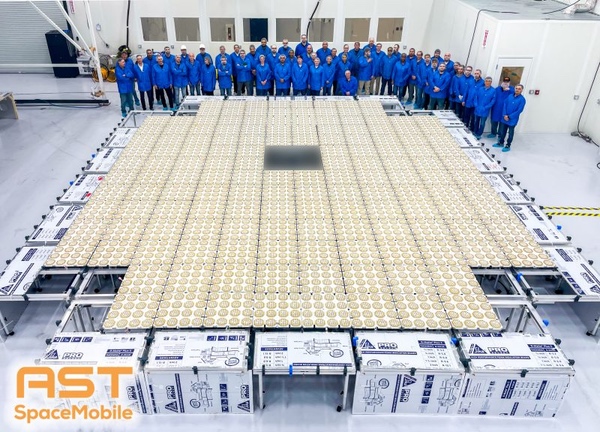Analyzing the deployment of BlueWalker 3by Brad Young
|
| If the entire constellation of 168 BlueBirds is launched, the effect on optical and radio astronomy would be perilous. |
The possible deleterious effect on optical and radio astronomy is alarming, in that we might be losing our ability to observe using multimillion-dollar telescopes and watch for incoming near-earth objects (NEOs). Early results, fortunately, show little effect. However, those results were based on the relatively faint Starlinks, which were modified by SpaceX for the express purpose of dimming their appearance. SpaceX has been responsive to the concerns of the astronomy community, but it is unclear if other operators will be as concerned.
Lately, the focus has been the prototype Blue Walker 3 launched in September 2022 by AST Space Mobile and recently fully deployed on orbit. The deployment unfolded an antenna array that is 64 square meters, the size of a small apartment and the largest commercial communications array in low earth orbit.
 The BlueWalker 3 satellite in orbit after it deployed its large antenna. (credit: AST SpaceMobile) |
Because of the size of the array, the CPS is concerned that if the entire constellation of 168 BlueBirds (the larger production model) is launched, the effect on optical and radio astronomy would be perilous.
To quantify the effect, the group has been observing BlueWalker 3 and recording its brightness before and after the deployment of the array. Several observatories and individuals across the globe have monitored the satellite before and after deployment of the array and the news is not good. The pre-deployment satellite appeared as a dim object, usually requiring binoculars to see, on a level with the post-darkening Starlinks.
Table 1: Brightness Change Observations
| UTC Date | UTC Time | Magnitude | Range (km) | Phase | Standard Magnitude |
|---|---|---|---|---|---|
| 10/3/2022 | 2:59:45 | 5.7 | 1867 | 128 | 3.31 |
| 10/4/2022 | 1:08:36 | 7.4 | 1110 | 122 | 6.35 |
| 10/5/2022 | 2:26:20 | 4.6 | 1107 | 120 | 3.63 |
| 10/7/2022 | 1:51:15 | 7.5 | 1006 | 123 | 6.63 |
| 10/8/2022 | 1:33:16 | 5.9 | 1048 | 125 | 4.87 |
| 10/9/2022 | 1:14:56 | 5.8 | 1125 | 136 | 4.17 |
| 10/10/2022 | 1:57:04 | 5.2 | 1159 | 138 | 3.40 |
| 10/23/2022 | 10:48:00 | 7.0 | 872 | 126 | 6.33 |
| AVERAGE STANDARD MAGNITUDE | 5.06 | ||||
| 11/12/2022 | 11:22:00 | 1.4 | 644 | 75 | 2.61 |
| 11/20/2022 | 0:37:00 | 1.4 | 869 | 79 | 1.89 |
| 11/21/2022 | 0:21:00 | 1.8 | 843 | 21 | 2.89 |
| 11/22/2022 | 0:02:22 | 2.0 | 771 | 32 | 3.23 |
| 11/22/2022 | 23:42:00 | 2.7 | 990 | 99 | 2.54 |
| 11/23/2022 | 1:21:00 | 3.6 | 1199 | 122 | 2.39 |
| 11/26/2022 | 0:28:00 | 3.7 | 1336 | 83 | 3.20 |
| AVERAGE STANDARD MAGNITUDE | 2.68 |
All observations above by author; these calculations use a simplistic model that may be too conservative in predicting the optical behavior of the large array when reflecting light.
After deployment of the array, the standard magnitude jumped by a factor of nine. Standard magnitude is a measure of brightness used by astronomers as a basis to compare different satellites. On a well-placed pass, this means BlueWalker 3 will typically appear as bright as a first magnitude star, with only 18 stars in the sky that are brighter. There are only a few other satellites this bright, notably the International Space Station and the new Chinese space station. A press release from the IAU explains the issue further.
But the true scale of the problem is that the production objects (BlueBirds) will be even larger, therefore almost certainly brighter. And there will be 168 of them in orbit. The cellphone system will require at least two of the satellites to be always in your sky to maintain call quality. During the summer, temperate zone areas (where most professional telescopes are installed) will see these crossing the sky nearly all night, requiring constant monitoring of them to avoid ruining images. Since they are 100 times brighter than Starlinks, there is real danger of damaging sensitive CCD and other imaging devices.
| The CPS will continue to monitor Starlinks and the BlueWalker/BlueBird flock. We must also prepare for other systems that have been announced. |
Because of these critical issues, the IAU CPS has accelerated its goal to contact AST SpaceMobile and find a solution. We are also involved in several other efforts to protect the night sky from what is becoming a real danger. Besides seeking a viable engineering solution to the problem, we are also engaging governments to modernize space policy and licensure to consider the effect of megaconstellations and bright objects. The effect on radio astronomy is also a major unknown, and the CPS is also working to address this issue.
Steps in the right direction include the formation of an office within the Federal Communications Commission (FCC), the Space Bureau, dedicated to space. Previously, there had been no specific group charged with considering the effect on the night sky, only the communications concerns such as frequencies used.
The CPS will continue to monitor Starlinks and the BlueWalker/BlueBird flock. We must also prepare for other systems that have been announced such as the European Union’s secure connectivity system (recently named Infrastructure for Resilience, Interconnectivity and Security by Satellite) and Guowang by China. Lessons learned now and systems put in place to determine brightness and work within international law may help mitigate the damage.
If you would like to contribute your observations to the scientific study, consider becoming an affiliated member of the CPS by applying here. Visual reports can be made via SatHub and images collected at Trailblazer. Satflare.com has a report generator and database of observations.
Read my article on how to observe satellites and drive their brightness to a fair accuracy. Or, if you would just like to see BlueWalker 3 for yourself, you can find its passes on Heavens Above and several other sources. If you have any questions about observing the spacecraft or what the CPS is trying to do, be sure to contact me via my website.
Finally, a video of BlueWalker 3 passing Deneb by Kevin Fetter:
Note: we are using a new commenting system, which may require you to create a new account.
